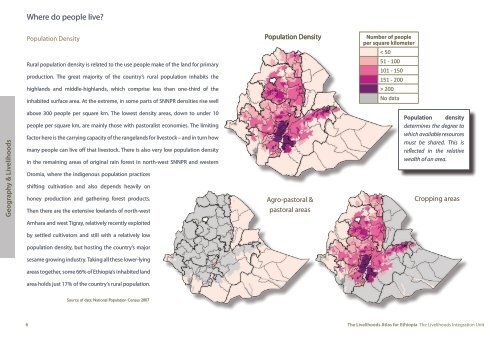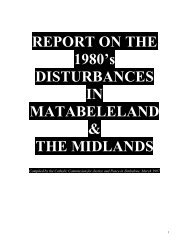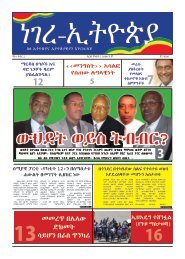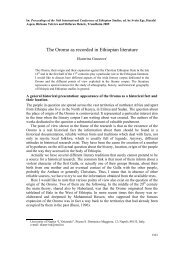Atlas Final Web Version 6_14
Atlas Final Web Version 6_14
Atlas Final Web Version 6_14
Create successful ePaper yourself
Turn your PDF publications into a flip-book with our unique Google optimized e-Paper software.
Where do people live?<br />
Population Density<br />
Rural population density is related to the use people make of the land for primary<br />
production. The great majority of the country’s rural population inhabits the<br />
highlands and middle-highlands, which comprise less than one-third of the<br />
inhabited surface area. At the extreme, in some parts of SNNPR densities rise well<br />
Population Density<br />
Number of people<br />
per square kilometer<br />
< 50<br />
51 - 100<br />
101 - 150<br />
151 - 200<br />
> 200<br />
No data<br />
Geography & Livelihoods<br />
above 300 people per square km. The lowest density areas, down to under 10<br />
people per square km, are mainly those with pastoralist economies. The limiting<br />
factor here is the carrying capacity of the rangelands for livestock – and in turn how<br />
many people can live off that livestock. There is also very low population density<br />
in the remaining areas of original rain forest in north-west SNNPR and western<br />
Oromia, where the indigenous population practices<br />
shifting cultivation and also depends heavily on<br />
honey production and gathering forest products.<br />
Then there are the extensive lowlands of north-west<br />
Agro-pastoral &<br />
pastoral areas<br />
Population density<br />
determines the degree to<br />
which available resources<br />
must be shared. This is<br />
reflected in the relative<br />
wealth of an area.<br />
Cropping areas<br />
Amhara and west Tigray, relatively recently exploited<br />
by settled cultivators and still with a relatively low<br />
population density, but hosting the country’s major<br />
sesame growing industry. Taking all these lower-lying<br />
areas together, some 66% of Ethiopia’s inhabited land<br />
area holds just 17% of the country’s rural population.<br />
Source of data: National Population Census 2007<br />
6 The Livelihoods <strong>Atlas</strong> for Ethiopia The Livelihoods Integration Unit







